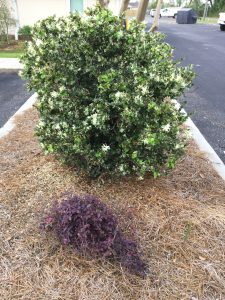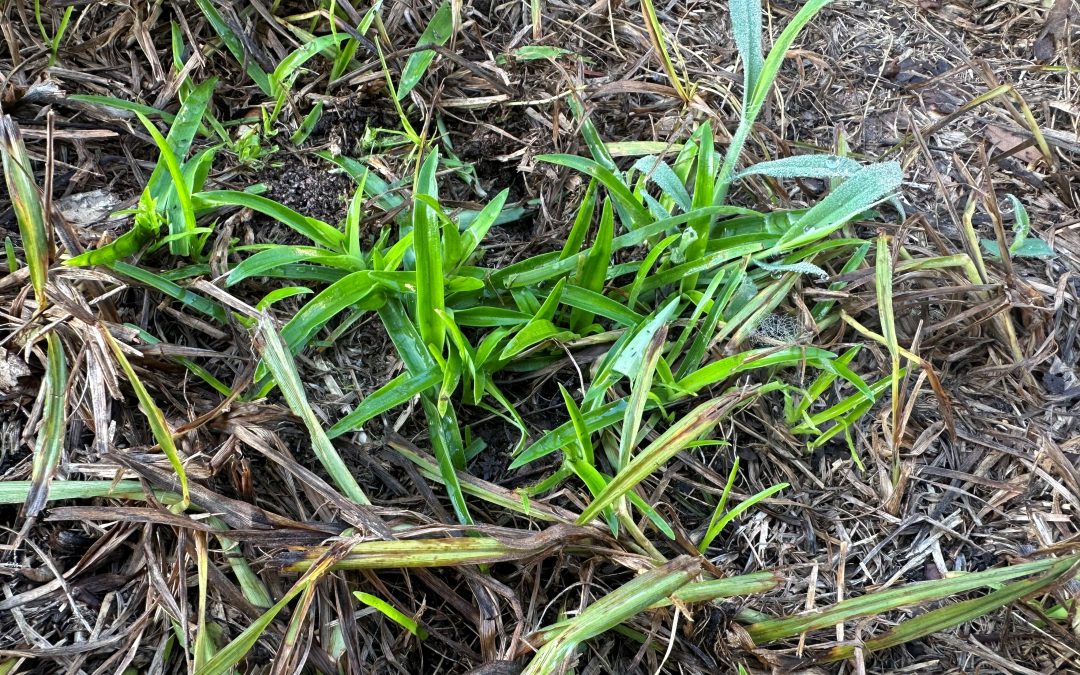
by Daniel J. Leonard | Jun 5, 2025
The Panhandle’s dreaded summer heat has finally arrived in force and has brought with it one of the most difficult to control lawn/landscape weeds, our annual enemy Doveweed (Murdannia nudiflora). Doveweed is characterized as one of the world’s worst weeds due to its broad range of growing conditions, ability to root along its stems, forming mats as it grows, massive seed production (each plant can produce up to 2,000 seeds per year), and inconspicuous nature – it looks like a grass to the untrained eye. So, what can gardeners do to control Doveweed that’s already up this year and prevent it next summer? Let’s find out.
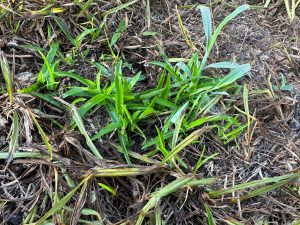
Doveweed emerging in a bare patch of a Centipedegrass lawn in late May 2025. Photo courtesy of Daniel Leonard.
First, the best prevention for all weeds, Doveweed included, is a healthy lawn/landscape. Ensuring healthy, thick Centipedegrass turf and landscaped beds that don’t allow light to hit bare soil goes a long way towards reducing the overall weed load lawns and landscapes can experience. For lawns, this can be achieved through mowing regularly at the proper height for your turfgrass (2.5” or so for Centipedegrass), irrigating no more than 0.75”-1” per week in the absence of rain, limiting stress from overfertilization, and removing excess thatch. In landscapes, preventative weed control focuses on limiting overwatering/fertilization and maintaining a 2-3” organic mulch layer of pinestraw, pine bark, leaves, wood chips, etc. Adopting these practices can greatly reduce the occurrence of weeds in your yard, however they will not eliminate weeds altogether and supplemental chemical weed control is often necessary.
Unlike Crabgrass, Florida Pusley, and other commonly encountered Panhandle annual weeds that emerge when the soil begins to warm in early spring (usually late February-March), Doveweed waits until mid-April-May (soil temperatures of 70-80 degrees F). All these annual weeds are best controlled by preemergent herbicides, like Indaziflam (Specticle G), before seeds germinate. For Doveweed, that means the first preemergent application should occur mid-April with a follow-up application 6-8 weeks later. However, for this year that opportunity is behind us and our only option is post emergent herbicides.
Which postemergent herbicide you choose depends on if your Doveweed issue is in turfgrass or in landscaped beds. In landscaped beds, the primary control option is either hand pulling or spot treating Doveweed with a 41% glyphosate product (Roundup and other generic products) at a rate of 3% (3-4oz glyphosate/gal). As glyphosate is a non-selective herbicide, be sure to not get any overspray on any ornamental plant foliage. In turfgrass, Doveweed control becomes a little more difficult. You essentially have three options – atrazine, a generic 3-way broadleaf product, or a commercial grade broadleaf product. Though it provides very good control of Doveweed and has pre-emergent properties to help discourage future weeds, I don’t prefer atrazine because it has a high potential to leach into groundwater following heavy rains in sandy soils, which describes much of the Panhandle. The generic 3-way products (usually a mix of Dicamba, Mecoprop, and 2,4-D) are fairly effective on Doveweed, however follow-up applications are usually required and the 2-4D component can be harsh on Centipedegrass at the higher label rates required for Doveweed control. Though somewhat expensive, the best post emergent option for most people is probably a commercial grade product like Celsius WG. Celsius WG is a very strong post emergent broadleaf herbicide that is very effective on Doveweed and is also very safe on Centipedegrass, even in hot weather. If the cost of the product (>$100) is off-putting, it is helpful to remember that even at the highest labelled rate, a 10 oz Celsius WG bottle goes a long way, enough to cover several acres of lawn.
* Regardless of what method you choose, be sure to get after emerged Doveweed seedlings early, before they mature and begin flowering – even the strongest post emergent herbicides work better on young weeds.
While Doveweed is a nasty little plant that is perfectly capable of taking over a lawn or landscaped bed, there are a variety of preventative and control options available. Using a combination of the above techniques should help achieve lasting Doveweed controls in future seasons! For more information about Doveweed and other summer annual weed control in lawns and landscapes, contact your local UF/IFAS Extension County office.

by Joshua Criss | Apr 21, 2025
Lawns are as American as apple pie, and Granny’s cookies. It’s where you play ball with your kids, and have summer cookouts. It’s also quite likely a huge source of frustration. How much water, how much fertilizer, how much work, and why bother? All of these are valid questions, and ones this article seeks to clarify. We’ll delve into the benefits of healthy lawns, and cover some easy cultural practices you can implement right now for a green and lush lawn all summer long.
The Benefits of Lawns
Turfgrass provides a number of ecological services. These are defined by the USDA as “direct and indirect benefits provided to humans by an ecosystem to include provisioning, regulating, supporting and cultural services”. This term has multiple categories, which are outlined below.
Provisioning (AKA Material and Energy Output)
Provisioning or material/energy output is linked to a grass’ bio-filtering capability. Grasses remove pollutants from applied water including stormwater, while enabling ground infiltration. This recharges surface reservoirs, and by removing pollutants, mitigates eutrophication while providing clean drinking water to communities.
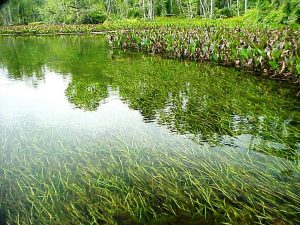
UF/IFAS Photo: Jess Van Dyke
Regulating (AKA Moderation and Control of Ecosystem Processes)
Grasses are known to cool the surrounding environment, capture dust, and prevent erosion.
Water absorbs heat as it vaporizes as it does in the evapotranspiration processes in plants. As Ben Franklin taught us many years ago, that process cools the environment around through heat absorption as water vaporizes. This cooling effect can be quite significant, and translates to saving through reduced air conditioning of your home.
Grasses remove dust and pollen particles from the air as well. This is usually a process by which wind blows the dust onto the grass, the dust settles and is captured beneath the grass canopy.
To complete the trifecta, grass has a thick root mass locking soil in place. The two main methods for soil erosion are through wind, and water flow. The grass’ root system negates both of these.
Supporting Services (AKA Maintaining Fundamental Ecosystem Processes)
Supporting services, as this sections title suggests, are those which support life processes. In the case of grasses, this comes in the form of organic matter. As I hear often, soils in Florida are quite sandy and lacking in the aforementioned organic matter.
It may surprise you to hear that grass is probably the easiest method to make these additions. As we leave clippings on the lawn and root systems slough off only to regrow the following spring we actually are adding organic matter from two directions. Hence grass’ reputation as a great soil builder.
This organic matter is where our supporting services really shine. Your turfgrass acts as habitat for microbiota, and macrobiota. These terms refer to the bacteria, fungi, algae, earthworms, and other insects which help cycle soil nutrients while breaking down the same organic matter you’ve added simply by not removing your grass clippings.
Cultural Services (AKA Societal Benefits)
These are somewhat self explanatory. It is in this realm where we begin to discuss those neighborhood block parties. Lawns are an excellent place to meet with neighbors and build communities. Well maintained lawns can also affect home prices, improve neighborhood aesthetics, and even effect crime rates in a given area.

UF/IFAS Photo
It Starts with Cultural Practices
Hopefully by now, you are sold on keeping a healthy stress free lawn. The real question is how to achieve one? You’ve likely heard that lawns are difficult to maintain, but you’ll be happy to know it’s much easier than advertised. You’ll see rapid results if you start paying attention to three practices.
Irrigation
Easily the biggest killer of grasses in North Florida is irrigation. Often too much is applied, and is at the wrong time of day. All turfgrass species in Florida require only ½ -3/4 inch of water per irrigation event. Water your grass before dawn when you notice bent grass blades, slight color changes, and a lack of rebound when stepped upon.
Not sure how much you’re applying? Place some containers in your watering zone spread evenly and run the system for 15 minutes. Measure that outcome with a ruler, adjust your timing as necessary to hit the right amount.
Fertilization
Fertilization is based on turfgrass species. Overdoing things can be quite harmful to your lawn, so make sure you check the Florida Lawn Handbook for the specifics on your grass species.
Before you get started fertilizing, there are a few bits of information of which you should be aware. The first is your soil’s pH, as it dictates nutrient availability for your grass. The second factor in fertilization is timing. Apply fertilizer in multiple applications beginning April 15th and ending in September. This ensures your grass will have enough root mass to utilize the nutrients.
Mowing
Our final cultural practice is mowing. It is critical to mow plant to the appropriate height. Mowing to proper height keeps grass stress free reducing susceptibility to insects, disease, drought or sunscald. Here again, height is dependent on grass species. Consult the Florida Lawn Handbook for greater detail.
Whatever the height required. Make sure to mow grass with sharp blades, only when dry, and weekly to avoid damage to your plants.
To Sum it All Up
Turfgrasses are an integral part of any landscape when sited correctly. They provide a wealth of functions both ecological and cultural. Take a little time to integrate the practices outlined above and you’ll discover an easy to maintain groundcover primed for your next family cookout. As always, if you have any questions or need any help on this topic and more, contact your local Extension Office.

by Mark Tancig | Feb 27, 2025
It’s almost March and it’s not just March Madness that’s about to happen, but No Mow March. This year will be the third year that the Horticulture Extension Agents of the UF/IFAS Northwest District have promoted No Mow March. The No Mow March campaign encourages those with lawns to leave some late winter/early spring wildflowers to benefit wildlife.
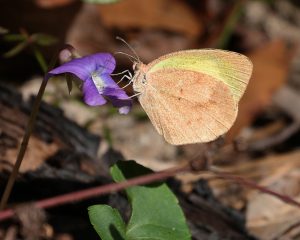
A Barred Yellow butterfly visit a violet, one of our late winter wildflowers that can be found in your lawn. Credit: Steve Coleman.
If you don’t think you’re ready to skip mowing the whole lawn for the whole month of March, then maybe you could try a small piece and hold off as long as you can. The point is to get you thinking of how your lawn, usually not considered an inviting place for most wildlife, can actually provide valuable ecosystem services. Many pollinator species in our area are emerging from their winter break and looking for food as we move into March. Plants in your lawn that are typically considered “weeds” are perfect pollinator feeders at a time when other landscape plants have yet to begin flowering. Providing extra floral resources can be especially useful in more developed areas where well-kept landscapes reduce what’s available for pollinators. Since the health and abundance of insect pollinators contribute to the ability of higher organisms, especially birds, if there’s more insects, then there’s more food for the birds, too!
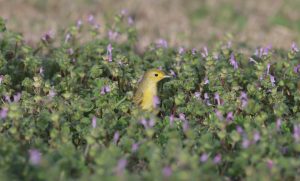
While you’re not mowing, try observing the wild plants and animals that visit your lawn. You can get help identifying them by using apps like iNaturalist or Seek. You could also spend some time ripping out part of the lawn and planting a new flower bed of native plants. Or you can focus on identifying any invasive plant species in your landscape and work on removing them.
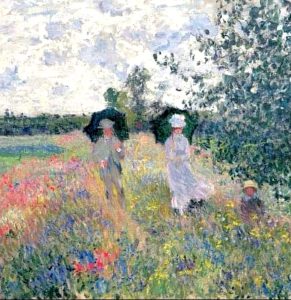
Instead of mowing, take a walk in the wildflowers during March. Credit: Taking a Walk near Argenteuil by Claude Monet.
The Horticulture Extension Agents of the UF/IFAS Extension Northwest District have put together a No Mow March website with more information, including a list of related workshops and classes, as well as a pledge you can take to affirm your choice to participate.

by Mark Tancig | Jan 16, 2025

Have a Happy, Green 2025!
This is the time of year where we often pledge to change and/or improve something about ourselves, but why not have a garden resolution, too. If you’d like a garden resolution or you’ve run out of personal resolution ideas (and you’re a gardener), then I have a couple of suggestions to help you garden with purpose this year.
Try to Accept more Imperfections in Your Landscape
Just like maybe we shouldn’t be so hard on ourselves or family members, we should also give our landscapes some grace. It’s hard to be perfect, and most landscapes have some minor, mostly aesthetic, imperfections, but that’s okay. Consider these landscape imperfections signs of character and what make it unique. Try to focus on the positive qualities of the overall landscape and not fixate on minor insect damage or a weed or two in the lawn. You may find that many of these issues clear themselves up on their own and your anxiety, worry, and efforts were not needed.
Reduce Pesticide Use
Somewhat dovetailing with accepting more imperfections, try and pledge to use less pesticides in your landscape. Many pesticides are applied in an attempt to fix minor landscape problems that often go away on their own. Based on numbers collected by various agencies, gardeners apply literal tons of pesticides to their ornamental landscapes. These products have environmental impacts and are often not fixing the problem, due to misdiagnosis, wrong timing of application, and/or other improper usage.
The UF/IFAS Florida-Friendly Landscaping™ Program has more information on how to manage landscape pests responsibly.
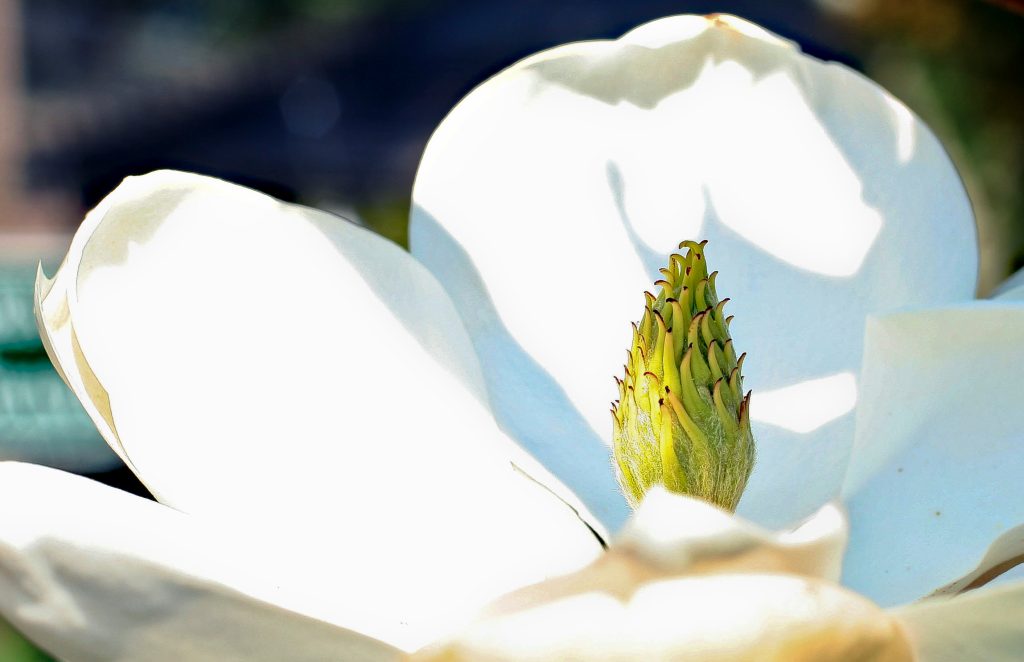
The native southern magnolia (Magnolia grandiflora) is a great native tree to plant in your landscape. Credit: Laura Ciociola.
Plant More Native Species
When thinking of new plantings or browsing the nursery, consider selecting native species for your landscape. Native species are more adapted to our native insects, diseases, soil conditions and climactic patterns. Native plants aren’t necessarily easier to grow – you still need to take care to get them well established – but they tend to be better able to handle the environmental stressors of our area. Additionally, native plants are most likely to benefit native wildlife species.
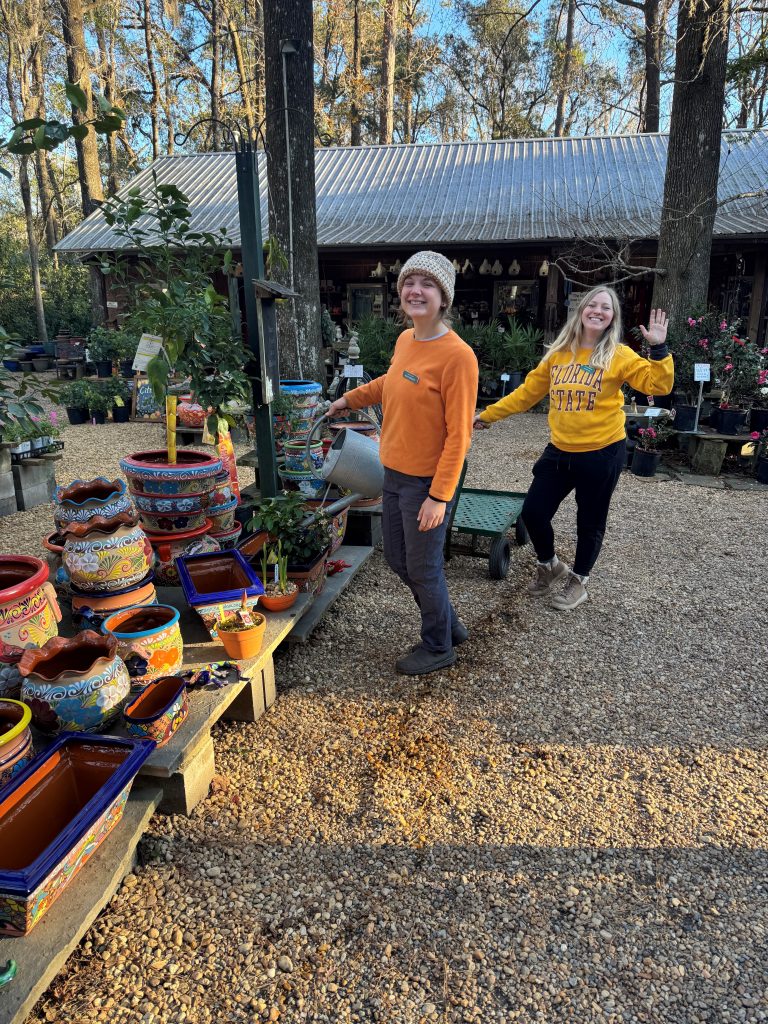
Local nurseries typically only offer plants well suited to your area and are your neighbors! Credit: Native Nurseries
Shop at Local Nurseries
When looking for those native plant species, try to support your local nursery businesses. Local nurseries tend to only carry the plants that are best suited to the area, and they’re your neighbors, too. To help find both native plant species and local nurseries, there is an association of Florida native plant nurseries (the Florida Association of Native Nurseries – FANN) that has a wonderful online search tool to find the perfect plant from the closest nursery.
Of course, don’t forget to utilize your local extension office if you decide to take on these resolutions. Whether it be help confirming that it is just a minor imperfection, help diagnosing a disease or insect problem, selecting native plant species, and or finding a local plant nursery, your local extension office can lead you in the right direction. UF/IFAS Extension’s Gardening Solutions webpage and Florida-Friendly Landscaping™ Program site also have plenty of online resources to help you have another successful and sustainable gardening year.
Happy New Year and Happy Gardening!
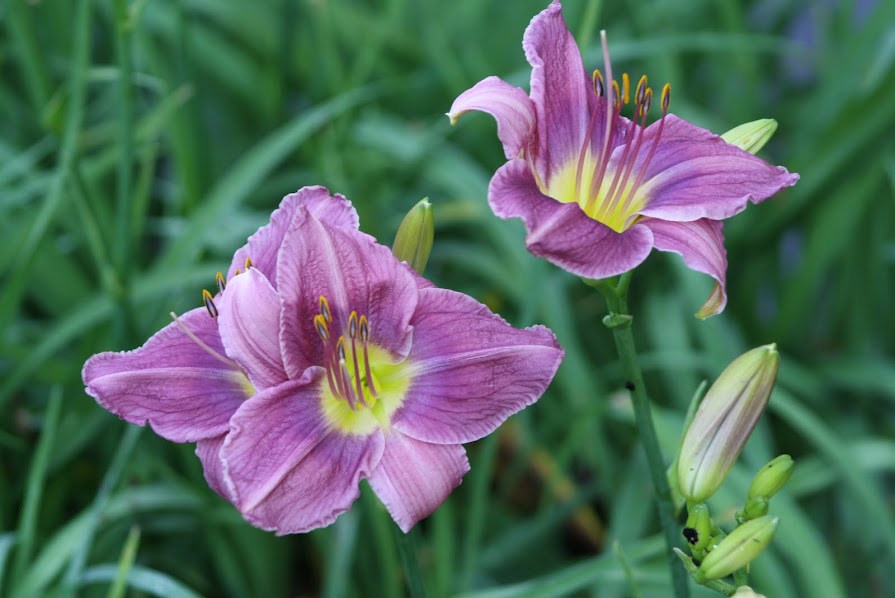
by Julie McConnell | Dec 18, 2024
Before my career in Extension, I spent ten years selling plants. I worked at a 40-acre nursery that was filled with thousands of plants. The selection was enormous and it was an eye-opening experience, even for a horticulturalist, to see how many different types of the same plant species were on the market. I learned quickly that if someone came in and said, “I need a daylily,” “I need a hydrangea,” or “I need a loropetalum” there were a lot more questions that needed to be asked to help them properly!
Plant breeders in ornamental horticulture spend their careers selecting plants for winning features that gardeners will line up to buy. Examples of traits include flower color, repeat flowering, mature size, disease resistance, cold hardiness, sun/shade tolerance, and foliage color. There are a lot of steps between recognizing what might be a superstar and availability in your local garden center, but let’s just jump to the part where they are in the garden center.
When shopping for plants, always look for the full name of the plant, preferably the botanical name which will include genus and species in Latin. Some plants are grown from seed and may have some variation in features. For example, a live oak grown from an acorn will be named with only genus and species, Quercus virginiana. The mature growth habit will have a wider range than one that was cultivated from a parent plant with known features. The species could be smaller than average, larger than average, an interesting branching feature, etc. Think of your own family, kids from the same parents may have different eye color, hair color, and height but they are all human children!
A cultivated plant is grown from cuttings or similar propagation methods that create a genetic clone of the originally selected plant. It is considered a cultivar if it will not grow true from seed and needs human intervention to result in the identical characteristics as the parent plant. The botanical name of a cultivated plant will follow the italicized species and is written/typed in single quotes. Note, since many plants are trademarked, there may be a botanical name that isn’t very flashy followed by a similar name, with some marketing flair. Let’s look at a couple of examples:
As you can see, just asking for a Loropetalum can result in vastly different plants!
Relying on common names only can also lead to an unintentional purchase. The same common name may be used for two very different plants. Another issue is that closely related species may have different places of origin and if you are trying to use only Florida native plants that could impact your design plans. Here are a couple of examples:
The takeaway message is always look for botanical names and do a little homework when purchasing plants. Ensure the plant you are looking at has the features that match your landscape needs!
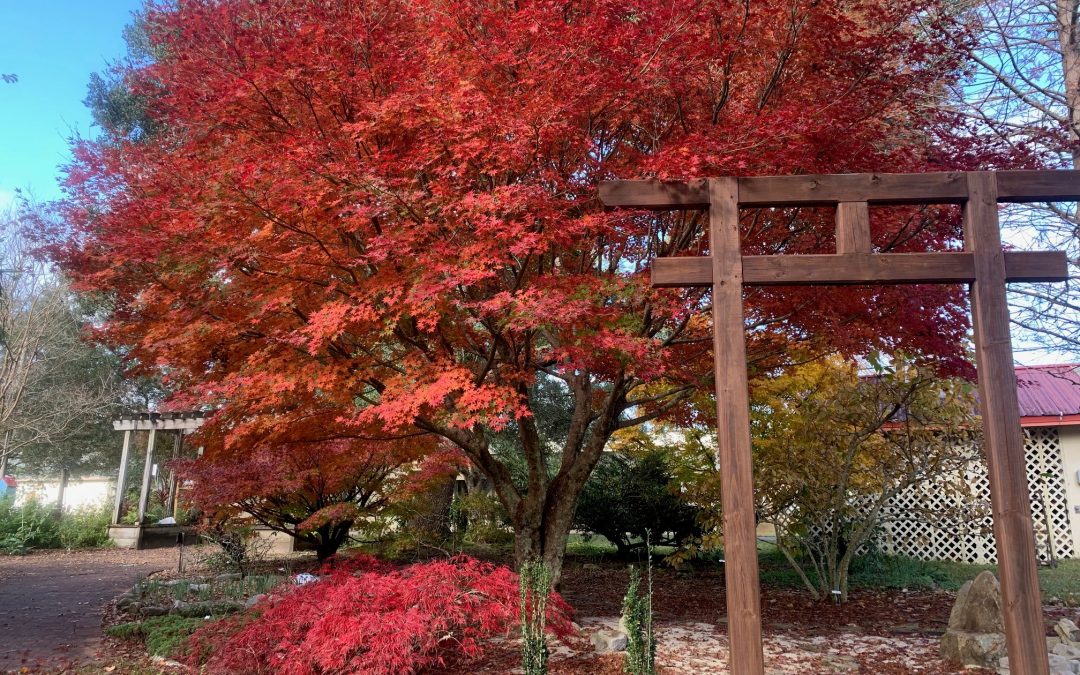
by Beth Bolles | Dec 13, 2024
When looking for a small tree that provides a visual impact in the landscape, nothing beats a Japanese maple.
In North Florida, we have landscapes with some suitable conditions for growing a Japanese maple but these trees are not for every site. Japanese Maple plants prefer some shade, especially in the afternoon, and protection from winds. If you have a high tree canopy that allows for filtered sun throughout the day, many cultivars will grow well with this light. Soils should be moist but well drained with good organic matter. Areas with higher pH soils such as home foundations or around concrete patios usually show plants with poorer growth and nutrient issues.
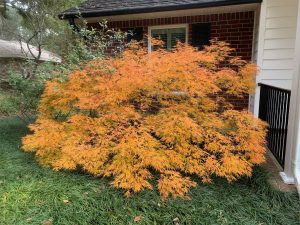
This specimen is suited to its spot with acid soil with a high Live oak tree canopy. The fall color is beautiful. Photo by Beth Bolles, UF IFAS Extension Escambia County.
Many people love the leaf color of Japanese maples, either burgundy leaf forms or selections with beautiful fall color. The palmate leaf shape also adds interest, along with varying degrees of coarse to finer textures.
My favorite characteristic of the Japanese maple is the growth form. Trees often have a layered appearance with branches extending outward, making a beautiful small canopy. Many selections have smooth bark but one cultivar, the Pine bark maple, has plated bark that looks like a pine tree.

Pine bark Japanese maple form and fall leaf color. Photo by Beth Bolles, UF IFAS Extension Escambia County.
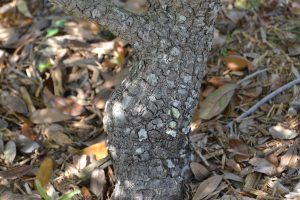
Interesting bark of the Pine bark maple. Photo by Beth Bolles, UF IFAS Extension Escambia County.
Although the growth rate is slow to moderate, be sure to research the plant size of the cultivar you want. There are small tree forms that will reach an average of 20 feet and plants that only grow about 5 feet in twenty years. Our cool season is the best time to plant a Japanese maple if your landscape is suited for this tree.















